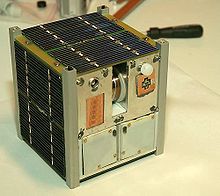CubeSat

A CubeSat is a type of space research picosatellite with dimensions of 10×10×10 centimetres (i.e., a volume of exactly one litre), weighing no more than one kilogram, and typically using commercial off-the-shelf electronics components.
Currently, a large number of universities and some companies and other organizations around the world are actively developing CubeSats [1]. With their relatively small size, CubeSats can be made and launched for an estimated US$65,000–80,000 each (2004 US dollars). This low price tag, as compared to most satellite launches, has made Cubesat a viable option for schools and universities across the world. Most CubeSats carry one or two scientific instruments as their primary mission payload. A few CubeSat projects have a limited propulsion system; for example, the CubeSat project of the University of Illinois uses an array of small ion thrusters.
Launch history
2003
On 30 June 2003, five university CubeSats and one commercial CubeSat were launched on a Rockot rocket from Russia’s Plesetsk launch site. The launch was executed by Eurockot Launch Services GmbH of Bremen, Germany. The CubeSats on board were:
- Aalborg University's AAU CubeSat
- Quakefinder's Quakesat
- Technical University of Denmark's DTUsat
- Tokyo Institute of Technology's CUTE-I
- University of Tokyo's XI-IV
- University of Toronto's CanX-1
2005
On 27 October 2005, a Kosmos-3M launch vehicle launched from Plesetsk carried three CubeSats into orbit on the SSETI Express mission. The CubeSats on board were:
- Norwegian University of Science and Technology's NCUBE2
- University of Tokyo's XI-V
- University of Würzburg's UWE-1
2006
On 21 February, a M-V launch vehicle launched from Uchinoura, Japan carried a single CubeSat into orbit, namely:
On July 26, 14 Cubesats from 10 universities, as well as a private company, were to be launched aboard a DNEPR Rocket, which failed and was destroyed during launch. California Polytechnic State University handled the details. This launch was postponed numerous times due to the primary payload, EgyptSat-1, not being ready. Due to ITAR concerns, the cubesats were moved to a different launch opportunity, with the primary payload from Belka. The launch was lost after the first stage engine shut down prematurely.[1][2]. It is currently believed that all satellite parts were destroyed. The launch carried:
- Rincon 1 by University of Arizona, U.S.
- SACRED by University of Arizona, U.S.
- KUTESAT-1 by University of Kansas, U.S.
On 9 December, three CubeSats were launched as a secondary payload aboard the Space Shuttle Discovery, on STS-116. These are the US Naval Acadamy's RAFT1 and MarsCOM, and DARPAs Mepsi-2.
Future Launches
- Seven Cubesats will be launched as a secondary payload on a DNEPR rocket on a currently unspecified day in 2006. This launch has been planned for a long time now, to be the second launch by Cal Poly.
Current running projects
A number of CubeSat projects are running in different universities currently. Some of them are:
- Tj^3Sat by Thomas Jefferson High School for Science and Technology, Alexandria VA: Plan to be the first highschool to successfully launch a satellite into space.
- BillikenSat-II by Parks College, Saint Louis University, U.S.
- Delfi-C3 by Delft University of Technology, The Netherlands : It is a 3-unit CubeSat 10x10x30 centimeters
- AAUSAT-II by Aalborg University, Denmark
- AubieSat-1 by Auburn University, U.S.
- Compass One by Fachhochschule Aachen, Germany
- TIsat-1 by the University of Applied Sciences of Southern Switzerland (SUPSI), Switzerland
- DTUsat-2 by Technical University of Denmark, Denmark
- CAPE-1 by University of Louisiana at Lafayette, U.S.
- CASsat jointly by University of Sydney and University of Technology, Sydney, Australia
- CAPE-1 by University of Louisiana at Lafayette, U.S.
- Hermes by University of Colorado at Boulder, U.S.
- PolySat by California Polytechnic State University, U.S.
- SwissCube by the Swiss Federal Institute of Technology, Switzerland
- MEROPE by Montana State University, Space Science and Engineering Laboratory
- KySat by a Consortium of Five Kentucky Universities, US
- Libertad 1 by Universidad Sergio Arboleda, Colombia
See also
References
- ^ "Space.com Report: Dnepr Rocket Crashes Shortly After Launch". Retrieved 2006-07-27.
- ^ SpaceFlight Now
- "Cubesat Community Website". Retrieved 2006-03-18.
External links
- CubeSat Program official website Contains information about the upcoming launch.
- Edusat Project
- First High School CubeSat Project
- Extensive list of Cubesat missions
- Delft University of Technology CubeSat project
- Aalborg University second CubeSat project
- Amsat's list of CubeSats Generally kept well up to date
